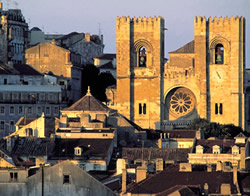|
About Lisbon:
Lisbon, which is called the "city of seven hills", is the political and economic capital of Portugal. It stretches along the north bank of the River Tagus in the westernmost country of mainland Europe. Initially located north of the castle of São Jorge, Lisbon long ago stopped being geographically restricted by the city walls, undergoing an expansion that was led by the Christian presence in the country.
 
Besides its various cultural traditions, Lisbon is also the setting for contrasting architectural styles, ranging from traditional neighbourhoods with narrow streets (Alfama, Mouraria, Bairro Alto and Chiado), which date from before the earthquake of 1755, to the neo-classical style of spaces such as "Praça do Comércio" and monuments such as the D. Maria II National Theatre. The devastating earthquake that struck the city centre in 1755, followed by a terrible fire, led to the reconstruction of much of the area, using a more precise geometrical grid structure that emphasised symmetry as a means of highlighting the monuments and statues, such as the Triumphal Arch and the statue of King José. Basically, Lisbon houses a vast range of influences that come together to produce a perfect combination of the classical and the modern.
The Jerónimos Monastery in Belém is an authentic hymn to Portugal's maritime tradition, while the Belém Tower is the royal symbol of Portuguese expansionism. Don't forget to go to the "Fábrica dos Pastéis de Belém" and enjoy one of the city's most loved traditional sweets.
 
Bairro Alto is one of the neighbourhoods that has preserved the asymmetrical streets typical of such 17th-century area, and is packed with shops, cafés and restaurants. For those who wish to know Lisbon better, choose one of the many restaurants there and savour one of the typical dishes made using cod. In some restaurants, your meal may be accompanied by the Portuguese guitar and you can hear fado being sung, creating a unique experience that your heart will never forget.
Now imagine flying over Lisbon and admiring the area that hosted the World Exhibition of 1998. This event not only enabled the area to be regenerated in urban and environmental terms, but also modernised and projected the city's image on the international stage. A trip on the aerial cable car, which takes you over a kilometre from the Vasco da Gama Tower to the Lisbon Oceanarium in the Parque das Nações, is one of the best ways to enjoy the amazing panoramic view of the park itself and over the River Tagus.
The more active can head off and discover the towns of Cascais and Estoril. Cascais used to be an iconic fisherman's village, and is now a beautiful and traditional town. Although the tourism industry has taken over it, you can still find some locals and the village's original charm. It's a nice place to go to when it's sunny, as the bay is very beautiful. Estoril is famous for being the home to one of Europe's biggest casino.
 
Trips to discover the secret places hidden away around Lisbon would not be complete without a visit to Sintra. Sintra was formerly the summer retreat of the kings of Portugal, and it has maintained the magic of ancient mediaeval towns. You can still find the influence of the Moorish occupation of Portugal during the Middle Ages, and gaze in wonder at the famous tiles in the streets, and on the façades and interiors of some buildings. For those who are tired and would like something sweet to eat, there are horse-drawn carriages to take you to one of the many tea-rooms, where you can enjoy the famous "travesseiros" and "queijadas de Sintra".

For more information please go to: http://www.visitlisboa.com/
|



